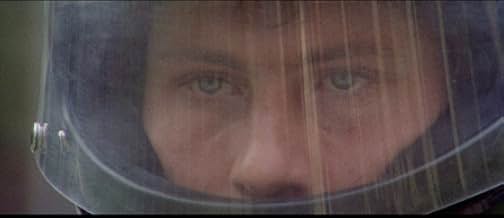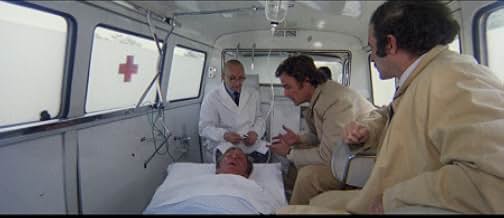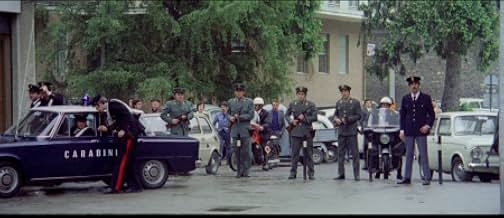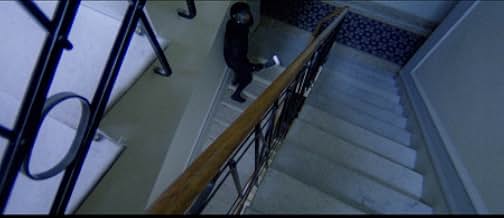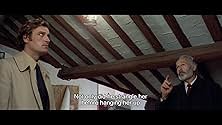VALUTAZIONE IMDb
6,9/10
2815
LA TUA VALUTAZIONE
La polizia indaga sull'apparente suicidio di un adolescente e scopre i dettagli di un'attività di prostituzione minorile. Vanno a caccia di un killer motociclista.La polizia indaga sull'apparente suicidio di un adolescente e scopre i dettagli di un'attività di prostituzione minorile. Vanno a caccia di un killer motociclista.La polizia indaga sull'apparente suicidio di un adolescente e scopre i dettagli di un'attività di prostituzione minorile. Vanno a caccia di un killer motociclista.
- Regia
- Sceneggiatura
- Star
Sherry Buchanan
- Silvia Polvesi
- (as Cheryl Lee Buchanan)
Recensioni in evidenza
Although the 'Giallo' genre officially began with Mario Bava's 'Ragazza Che Sapeva Troppo' (aka 'Evil Eye', or 'The Girl Who Knew To Much') in 1963, continuing with the same director's 'Sei Donne Per L'Assassino' ('Blood and Black Lace', 1964), it wasn't really until the commercial success of Dario Argento's 1969 debut, 'L'Uccello dalle Piuma di Cristallo' ('The Bird With the Crystal Plumage') that it really got underway to become a staple of Italian cinema in the 1970's. The films essentially were bloody thrillers in which the primary thrill was in watching pretty young girls being stalked and dispatched by anonymous, leather-gloved assassins. Stylistically these films forced the audience to identify with the killer, featuring lengthily protracted and elaborately staged sequences of women in terror strung together by a convoluted whodunnit plot along the lines of those of early twentieth century British crime-writer Edgar Wallace.
In fact, director Massimo Dallamano's previous film, 'Whatever Happened to Solange?' ('Cosa Avete Fatto a Solange?' 1972) was based on an Edgar Wallace novel. The follow-up takes it's cue from the same film by also setting itself within a girl's school, giving us a whole host of young nubiles around which to build the plot. The film opens with a rousing score courtesy of Stelvio Cipriani, a big-band romp through 70's flower-power accompanied by shots of the young girls getting on and off of their boyfriends scooters outside the school gates. This is followed by the discovery by the police of a young girl swinging naked from the rafters of an attic in a nearby deserted house after an anonymous tip off.
As the Italian title 'La Polizia Chiede Aiuto' (The Police Ask For Help) suggests, and what sets this apart from its predecessor and most of the Giallo films of the period, is that a lot of time is devoted to the police's detective work and the milieu of the police themselves as opposed to those of the potential victims, bringing the film more in line with the policier drama than pure 'Giallo'. For the most part the film follows these investigations from suspect to suspect, with each plot point highlighted by a lengthy flashback. A motorcycle chase forms one of the action set-pieces alongside the usual suspense scenes, including a taut sequence in which the female detective (Giovanni Ralli) is stalked by the leather-clad, helmeted killer with a meat cleaver. The gorier pay-offs mainly occur towards the end, once the cleaver has made its initial appearance, but along the way we discover a mutilated body in the back of a car, and the blood spattered bath in which it was dismembered.
If all this sounds rather perfunctory so far, it is the sheer bleakness of the film that distinguishes it. The initial murder is linked to the discovery of a school girl prostitution ring, and this central concept pretty much summarises the whole tone of the film. With a potential political scandal hinted at, and a scene in which the Claudio Casinelli's police investigator lies to the press to buy more time, the general milieu invoked is a corrupt and sordid one, where corruption and vice are masked by the superficially angelic innocence of the girls involved. The deadpan and po-faced narrative includes lengthy scenes of the police listening intently and repeatedly to tapes made of the call-girls' meetings, and graphic post-mortem descriptions of the victims. Salacious tit-bits like these are so deeply engrained within the complex plot that forces one is forced into a particularly bizarre and twisted perspective of the world by the accumulation of such elements.
Director Dallamano was a cinematographer turned director who had worked on a number of spaghetti Westerns in the 60's including Sergio Leone's 'Per un pugno di dollari' ('Fistful of Dollars', 1964). Prior to this he had made a number of films including adaptations of Oscar Wilde's 'Dorian Gray' (1970) and Leopold von Sacher-Masoch's 'Venus in Furs' ('Le Malizie de Venere', 1969)
'La Polizia Chiede Aiuto' also sports features an undistinguished supporting role from former Stranger on a Train, Farley Granger (Alfred Hitchcock, 1951). It is competently made, fast moving and gripping in places. It's worth checking out, but a maybe a little too serious in both its sleazy theme and its approach to prove a major crowd pleaser.
In fact, director Massimo Dallamano's previous film, 'Whatever Happened to Solange?' ('Cosa Avete Fatto a Solange?' 1972) was based on an Edgar Wallace novel. The follow-up takes it's cue from the same film by also setting itself within a girl's school, giving us a whole host of young nubiles around which to build the plot. The film opens with a rousing score courtesy of Stelvio Cipriani, a big-band romp through 70's flower-power accompanied by shots of the young girls getting on and off of their boyfriends scooters outside the school gates. This is followed by the discovery by the police of a young girl swinging naked from the rafters of an attic in a nearby deserted house after an anonymous tip off.
As the Italian title 'La Polizia Chiede Aiuto' (The Police Ask For Help) suggests, and what sets this apart from its predecessor and most of the Giallo films of the period, is that a lot of time is devoted to the police's detective work and the milieu of the police themselves as opposed to those of the potential victims, bringing the film more in line with the policier drama than pure 'Giallo'. For the most part the film follows these investigations from suspect to suspect, with each plot point highlighted by a lengthy flashback. A motorcycle chase forms one of the action set-pieces alongside the usual suspense scenes, including a taut sequence in which the female detective (Giovanni Ralli) is stalked by the leather-clad, helmeted killer with a meat cleaver. The gorier pay-offs mainly occur towards the end, once the cleaver has made its initial appearance, but along the way we discover a mutilated body in the back of a car, and the blood spattered bath in which it was dismembered.
If all this sounds rather perfunctory so far, it is the sheer bleakness of the film that distinguishes it. The initial murder is linked to the discovery of a school girl prostitution ring, and this central concept pretty much summarises the whole tone of the film. With a potential political scandal hinted at, and a scene in which the Claudio Casinelli's police investigator lies to the press to buy more time, the general milieu invoked is a corrupt and sordid one, where corruption and vice are masked by the superficially angelic innocence of the girls involved. The deadpan and po-faced narrative includes lengthy scenes of the police listening intently and repeatedly to tapes made of the call-girls' meetings, and graphic post-mortem descriptions of the victims. Salacious tit-bits like these are so deeply engrained within the complex plot that forces one is forced into a particularly bizarre and twisted perspective of the world by the accumulation of such elements.
Director Dallamano was a cinematographer turned director who had worked on a number of spaghetti Westerns in the 60's including Sergio Leone's 'Per un pugno di dollari' ('Fistful of Dollars', 1964). Prior to this he had made a number of films including adaptations of Oscar Wilde's 'Dorian Gray' (1970) and Leopold von Sacher-Masoch's 'Venus in Furs' ('Le Malizie de Venere', 1969)
'La Polizia Chiede Aiuto' also sports features an undistinguished supporting role from former Stranger on a Train, Farley Granger (Alfred Hitchcock, 1951). It is competently made, fast moving and gripping in places. It's worth checking out, but a maybe a little too serious in both its sleazy theme and its approach to prove a major crowd pleaser.
A young naked schoolgirl is found hanged in a room locked from the inside, the police suspect suicide, until that is the clues seem to point in the direction of murder. So when the police led by Inspector Silvestri(Claudio Cassinelli) with the assistance of the asst district attorney Vittoria Stori (Giovanna Ralli) realise that they are investigating a teen prostitute ring with some highly influential people involved, they know they are going to have a tough time convicting anyone and sure enough their investigation is dogged with interference and dead ends. Dallamano director of What have they done to Solange? again returns to his schoolgirl in peril themed story and like its predecessor it's a highly controversial topic that is handled professionally and intelligently. Despite its topic, there's very little in the way of visual sleaziness here, the offences against the girls are confined to tape recordings the police have and its from these that they build their case. The film is in fact only half Giallo and plays more like a Poliziotteschi (Italian police procedure film), we only get brief glimpses of the leather clad killer as he tries to cover up his identity by killing those who might be able to give him away. Stelvio Cipriani again provides an excellent score, the film looks good visually, no more than you'd expect from a director who used to ply his trade as a cinematographer, there's also a very memorable chase scene that livens up the film immensely. Claudio Cassinelli and Cortese provide some fine acting in their respective roles, if there is such thing as a high brow Giallo this must surely be it.
Second in Dallamano's schoolgirls-getting-killed trilogy, it's not as good as Who's Next? (Solange) but not bad in its own right. The killer is someone who rides a motorino (hey, it is Italy!) and never takes off his/her riding helmet, ala Magnum Force, the 2nd Dirty Harry film. This one's more exciting than scary, as the police hunt down this maniac. He's one of the cooler villains in film history though, because unlike the traditional drag-ass killer, this guy never speaks and just RUNS at you with a machete. He really SPRINTS at top speed, which is actually very scary, especially to a jaded horror buff used to the Michael Myers/Jason/zombie method of ambling on over to their victims, who usually have to trip in order to be caught. And there's one scene involving a light switch that will make you jump out of your undies. Stelvio Cipriani's score is again top-notch (he later reused part of it for Tentacles), the dubbing tolerable.
'What Have They Done To Our Daughters?' is an above average giallo directed by Massimo Dallamano, who was the cinematographer for Leone's spaghetti western classic 'For A Few Dollars More'. It's a kinda sorta sequel to 'What Have They Done To Solange?', which I haven't seen. But I have seen Dallamano's swinging De Sade 'Venus In Furs' and both movies have made me very interested in his work. The story concerns a police investigation into the shocking murder of a teenage girl which uncovers a prostitution ring. It stars Giovanna Ralli who was in another pretty good giallo 'Cold Eyes Of Fear' and Claudio Cassinelli who co-starred in the nunsploitation classic 'Flavia The Heretic'. It's also quite a surprise to see Farley Granger (of Hitchcock's classics 'Rope' and 'Strangers On A Train') in the supporting cast, though his performance is forgettable. Giallo fans will enjoy this one, but if you are new to genre try some Dario Argento (especially 'Tenebre') or Fulci's 'Don't Torture A Duckling' to see some of the best examples of this style of thriller. Still, this is a pretty good movie with some gruesome and sensationalistic touches.
A school-girl is found hung naked in a loft. Initially thought suicide, it soon becomes clear it was a murder. The discovery leads to a sordid case involving an underage prostitute ring and bloody mutilation.
What Have They Done to Your Daughters? is pretty much a companion piece to director Massimo Dallamano's other similarly themed film What Have You Done to Solange? Both movies share stories about murder and abuse of school-girls. As a result they both are a little more downbeat than is usual in this category of film, they aren't as graphically violent as other similar movies either, as the bleak story lines are unpleasant enough as they are. Where Solange was a giallo, this film is a hybrid of the giallo and poliziotteschi; for while there is a murder-mystery plot, the emphasis is squarely on the police procedural side of things. To be fair though this is an excellent show-case for both Italian sub-genres. From the poliziotteschi side of things we have a brilliantly shot and pulse-pounding motorcycle chase scene where a leather clad killer is pursued through the streets by police in a high speed chase; alternatively from the giallo side of the coin there is an intensely suspenseful scene set in an underground car-park where the killer stalks the heroine. In other words what makes Dallamano's film so good is that he is so adept at delivering the goods in both sub-genres.
The two leads are very good. Giovanni Ralli (Cold Eyes of Fear) and Claudio Cassinelli (Flavia the Heretic) as both believable and strong in their respective roles as the police in pursuit of the killer. To accompany things nicely is a very good score from Stelvio Cipriani; it accentuates the suspense moments to a significant degree and surely must be one of his best soundtracks. As you may also expect, it's photographed very well too. So stylistically this is a strong feature but what elevates it more is the unexpectedly serious-minded tone and story which also comments on political corruption. Its cynicism and downbeat nature are mediated, however, with more typical gruesome touches such as a man having his hand hacked off and an autopsy scene involving a torso cut into many pieces.
I've got to recommend this one to my fellow Italian genre enthusiasts. It's the best combination of the giallo and poliziotteschi I am aware of. Its mystery is consistently compelling and it's directed with considerable skill. Well worth tracking down.
What Have They Done to Your Daughters? is pretty much a companion piece to director Massimo Dallamano's other similarly themed film What Have You Done to Solange? Both movies share stories about murder and abuse of school-girls. As a result they both are a little more downbeat than is usual in this category of film, they aren't as graphically violent as other similar movies either, as the bleak story lines are unpleasant enough as they are. Where Solange was a giallo, this film is a hybrid of the giallo and poliziotteschi; for while there is a murder-mystery plot, the emphasis is squarely on the police procedural side of things. To be fair though this is an excellent show-case for both Italian sub-genres. From the poliziotteschi side of things we have a brilliantly shot and pulse-pounding motorcycle chase scene where a leather clad killer is pursued through the streets by police in a high speed chase; alternatively from the giallo side of the coin there is an intensely suspenseful scene set in an underground car-park where the killer stalks the heroine. In other words what makes Dallamano's film so good is that he is so adept at delivering the goods in both sub-genres.
The two leads are very good. Giovanni Ralli (Cold Eyes of Fear) and Claudio Cassinelli (Flavia the Heretic) as both believable and strong in their respective roles as the police in pursuit of the killer. To accompany things nicely is a very good score from Stelvio Cipriani; it accentuates the suspense moments to a significant degree and surely must be one of his best soundtracks. As you may also expect, it's photographed very well too. So stylistically this is a strong feature but what elevates it more is the unexpectedly serious-minded tone and story which also comments on political corruption. Its cynicism and downbeat nature are mediated, however, with more typical gruesome touches such as a man having his hand hacked off and an autopsy scene involving a torso cut into many pieces.
I've got to recommend this one to my fellow Italian genre enthusiasts. It's the best combination of the giallo and poliziotteschi I am aware of. Its mystery is consistently compelling and it's directed with considerable skill. Well worth tracking down.
Lo sapevi?
- QuizFarley Granger's voice was dubbed by another actor in the English-language version.
- BlooperIn the scene when Cassinelli and Ralli are looking at a strip of film footage, they repeatedly stop the projector to pause on a single frame. However, the shadow of the projector plainly reveals that it is still rolling.
- Citazioni
Sgt. Giardina: [after speaking with Talenti's wife] I'll tell you one thing, I don't blame Talenti for leaving that... scary!
- Curiosità sui creditiImmediately after opening credits: "Every day we read or hear about brutal things that happen and which appear to have no logical explanation. Only a faithful reconstruction of such incidents can bring to light the dramatic and disturbing truth behind them."
- ConnessioniFeatured in Innocence Lost (2015)
- Colonne sonoreLa polizia sta a guardare
from La polizia sta a guardare (1973) (uncredited)
Written by Stelvio Cipriani
Performed by Stelvio Cipriani
Courtesy of IDM Music o/b/o Bixio Music Group
I più visti
Accedi per valutare e creare un elenco di titoli salvati per ottenere consigli personalizzati
- How long is What Have They Done to Your Daughters??Powered by Alexa
Dettagli
- Data di uscita
- Paese di origine
- Lingua
- Celebre anche come
- What Have They Done to Your Daughters?
- Luoghi delle riprese
- Manerba del Garda, Lombardia, Italia(segment)
- Azienda produttrice
- Vedi altri crediti dell’azienda su IMDbPro
- Tempo di esecuzione
- 1h 31min(91 min)
- Mix di suoni
- Proporzioni
- 2.35 : 1
Contribuisci a questa pagina
Suggerisci una modifica o aggiungi i contenuti mancanti


